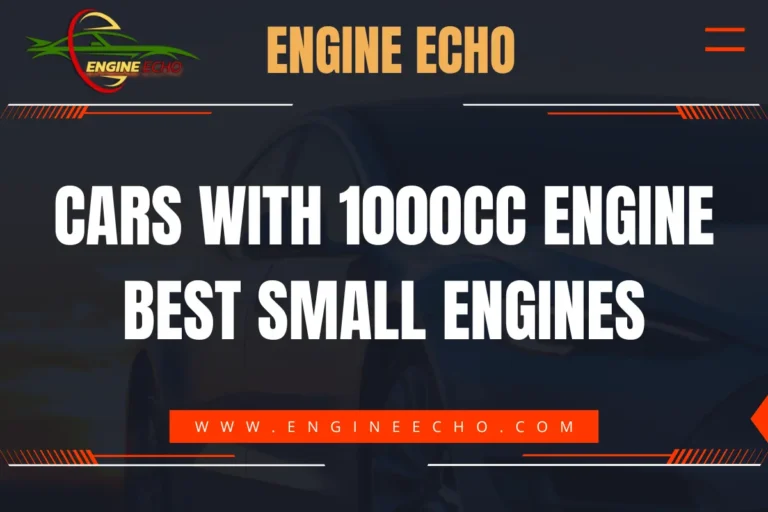Dual Overhead Cam Engine: Advantages and Features

Key Takeaways
- Performance Boost: DOHC engines deliver higher horsepower and torque, offering superior performance over SOHC engines.
- Enhanced Fuel Efficiency: Improved combustion efficiency in DOHC engines leads to reduced fuel consumption.
- Improved Emissions Control: DOHC engines provide better control over exhaust gases, ensuring compliance with stringent emission standards.
- Durability: With the right care, DOHC engines can keep running smoothly for years, saving you from a lot of headaches down the road.
- Modern Applications: DOHC engines are widely used in high-performance vehicles, motorcycles, and even in hybrid vehicles.
Introduction to Dual Overhead Cam (DOHC) Engines
When it comes to automotive technology, engines are where the magic happens. Among all the different configurations out there, the Dual Overhead Cam (DOHC) engine has always caught my attention. Not just because of its impressive performance, but because it strikes an incredible balance between power and efficiency. That’s why I couldn’t resist diving deeper into the world of DOHC engines—I’ve learned some pretty cool things, and I’m excited to share them with you.
How DOHC Engines Work
I remember the first time I encountered a DOHC engine—it was during a test drive of a car that promised high performance, and it did not disappoint. As I pressed down on the accelerator, the car seemed to respond instantly, and I realized just how much the dual camshafts were doing behind the scenes.
In a DOHC engine, there are two camshafts in the engine’s cylinder head—one for the intake valves and one for the exhaust valves. This setup allows for precise control over valve timing, making the engine breathe more efficiently. While SOHC engines get the job done, DOHC engines take it up a notch by letting more air in and out, which is a game-changer for performance.
Key Components of DOHC Engines
Each part of a DOHC engine plays a crucial role in delivering the performance that car enthusiasts, like myself, have come to appreciate:
- Camshafts: The dual camshafts in a DOHC engine ensure that the intake and exhaust valves open and close at the optimal times. I first noticed the impact of this when I worked on my own car. The difference in performance, especially at higher RPMs, was night and day.
- Valves: With four valves per cylinder—two for intake and two for exhaust—the engine can manage airflow much more effectively. I’ve compared this with SOHC engines, and the power delivery in DOHC engines is just on another level.
- Timing Belt/Chain: The timing belt or chain synchronizes the camshafts and crankshaft, keeping the engine running smoothly. The first time I replaced a timing belt on a DOHC engine, the precision needed really hit home—one small mistake, and you could end up compromising the engine’s performance.
- Cylinder Heads: These are specifically designed to house dual camshafts and optimize airflow and combustion efficiency. It’s a marvel of engineering that directly contributes to the power these engines deliver.
Advantages of Dual Overhead Cam Engines
Based on my experiences, I can confidently say that DOHC engines offer several standout advantages that make them worth considering:
- Performance:
- Increased Horsepower and Torque: The first time I drove a car with a DOHC engine, the increase in power was undeniable. The ability to achieve higher horsepower and torque is one of the main reasons I’m such a fan of this engine type.
- Higher RPM Capability: DOHC engines can operate at higher RPMs without losing performance, making them ideal for anyone who loves the thrill of pushing their car to its limits.
- Fuel Efficiency:
- Improved Combustion Efficiency: The precise control over valve timing results in more complete fuel combustion, boosting both power and efficiency—a win-win in my book.
- Reduced Fuel Consumption: This efficiency has made DOHC engines the go-to choice for modern vehicles where fuel economy is key.
- Emission Control:
- Better Control of Exhaust Gases: DOHC engines excel at managing exhaust gases, which is crucial for meeting strict emission standards. As someone who values sustainability, this is a big plus.
- Compliance with Emission Regulations: The ability to meet or exceed environmental standards is another reason I believe DOHC engines are here to stay.
- Maintenance and Durability:
- Reduced Wear and Tear: With more evenly distributed workloads across the camshafts and valves, DOHC engines typically experience less wear and tear. Trust me, this means less stress and more driving fun in the long run.
- Extended Engine Lifespan: Proper maintenance can significantly extend the life of a DOHC engine, something I’ve seen firsthand with vehicles that have clocked over 200,000 miles.
DOHC vs. SOHC Engines
Comparing DOHC and SOHC engines is like comparing apples and oranges—they each have their merits, but for me, the choice is clear:
- Performance Comparison:
- Power Output Differences: DOHC engines generally produce more power, which is immediately noticeable when you step on the gas. I’ve felt this difference on the road, where the extra power and torque make every drive more enjoyable.
- RPM Range and Response Time: DOHC engines have a higher RPM range, allowing for quicker acceleration and better responsiveness, something I’ve come to appreciate during spirited drives.
- Cost Analysis:
- Manufacturing and Repair Costs: While DOHC engines are more complex and can be more expensive to repair, the performance gains are well worth the extra cost.
- Long-Term Ownership Costs: Sure, DOHC engines might cost a bit more upfront, but the fuel savings and reliability down the road are totally worth it.
- Complexity and Design:
- Mechanical Complexity: The increased number of components in a DOHC engine makes it more mechanically complex, which might intimidate some, but for me, this complexity is part of the appeal.
- Impact on Vehicle Design and Weight: DOHC engines can be heavier, but the performance benefits often outweigh this drawback.
Applications of DOHC Engines
DOHC engines have found their way into a variety of vehicles, and for good reason:
- Automotive Industry:
- Common Vehicles Utilizing DOHC Engines: From sedans to SUVs, many vehicles today utilize DOHC engines. I’ve driven a range of these vehicles, and the performance difference is clear across the board.
- Examples from Various Car Manufacturers: Brands like Honda, Toyota, and Ford frequently employ DOHC engines in their vehicles, especially in models where performance is a key selling point.
- Motorcycles:
- Popular Motorcycle Models with DOHC: High-performance motorcycles, such as those from Yamaha and Ducati, often feature DOHC engines. If you’re into bikes, riding one with a DOHC engine is something you just have to try—it’s a thrill like no other.
- Performance Benefits in Two-Wheelers: DOHC engines in motorcycles allow for higher RPMs and faster acceleration, making them ideal for racing and performance-focused motorcycles.
- Racing and High-Performance Vehicles:
- Role of DOHC in Motorsports: DOHC engines are a staple in motorsports, where every bit of extra power and responsiveness counts. I’ve seen these engines in action on the track, and their performance is nothing short of impressive.
- Custom-Built DOHC Engines for Racing: Many racing teams opt for custom-built DOHC engines to maximize performance. It’s fascinating to see how these engines are pushed to their limits in competitive settings.
DOHC in Modern Automotive Design
As someone who follows automotive trends closely, it’s exciting to see how DOHC engines are being integrated into modern vehicles:
- Integration with Turbochargers and Superchargers:
- Enhanced Performance in Turbocharged Engines: Combining DOHC with turbocharging provides significant power boosts, making it a common setup in performance cars. I’ve driven a few turbocharged DOHC engines, and the combination is nothing short of thrilling.
- Supercharging and Its Effects on DOHC Engines: Superchargers can further enhance the power output of DOHC engines, though at the cost of increased fuel consumption. It’s a trade-off I’m willing to make for the extra power.
- Hybrid and Electric Vehicles:
- Transitioning Technologies: While hybrid and electric vehicles are becoming more common, DOHC engines still play a role in performance-oriented hybrids. I’m curious to see how these engines will continue to evolve in the coming years.
- The Future of DOHC in Hybrid Powertrains: As hybrid technology advances, I believe DOHC engines will remain relevant, particularly in plug-in hybrids that need both high efficiency and performance.
Common Myths and Misconceptions about DOHC Engines
There are a few misconceptions about DOHC engines that I’ve encountered over the years:
- Misconception 1: “DOHC engines are only for high-performance cars.”
This is far from the truth. While DOHC engines excel in high-performance settings, they are also used in a wide range of everyday vehicles, providing a blend of efficiency and power. - Misconception 2: “DOHC engines are harder to maintain.”
While more complex, DOHC engines don’t necessarily require more maintenance than SOHC engines. As long as you follow the recommended maintenance schedule, they’re just as reliable. - Misconception 3: “SOHC engines are more reliable.”
Both engine types can be reliable when properly maintained. However, I’ve found that DOHC engines often offer better performance and efficiency, making them a preferable choice for many drivers.
Maintenance Tips for DOHC Engines
Maintaining a DOHC engine isn’t as daunting as it might seem, especially with a bit of hands-on experience:
- Regular Inspection:
- Importance of Timing Belt/Chain Checks: Ensuring the timing belt or chain is in good condition is crucial. I’ve learned this the hard way—one skipped maintenance check can lead to significant engine issues.
- Monitoring Valve Clearances: Regularly checking and adjusting valve clearances can prevent issues with engine performance. It’s a small task that can save you from bigger problems down the road.
- Lubrication:
- Best Oil Types for DOHC Engines: Using high-quality, manufacturer-recommended oil ensures that the engine’s moving parts remain well-lubricated. I’ve always stuck to this rule, and it has paid off in the longevity of my engines.
- Recommended Oil Change Intervals: Adhering to recommended oil change intervals is essential for maintaining engine health. I never skip an oil change, and my engines have rewarded me with smooth, reliable performance.
- Cooling System Care:
- Ensuring Optimal Engine Temperature: Keeping the cooling system in good working order prevents overheating, which is particularly important in high-performance DOHC engines. I make it a point to check my coolant levels regularly.
- Common Cooling Issues in DOHC Engines: Regularly inspecting the radiator, hoses, and coolant levels helps avoid overheating and related damage. It’s a simple step that can prevent major issues.
Future Trends in DOHC Technology
As an enthusiast, I’m always excited about what’s next in automotive technology, and DOHC engines are no exception:
- Advanced Materials:
- Development of Lightweight, Durable Components: The use of advanced materials like composites and alloys is making DOHC engines lighter and more durable. I’m all in on this trend because the benefits are just too good to pass up.
- Use of Composites and Alloys: These materials improve engine efficiency and reduce weight, contributing to better overall vehicle performance. It’s a trend I fully support, given the benefits it brings.
- Variable Valve Timing (VVT):
- Integration with DOHC for Better Performance: VVT allows for even more precise control over valve timing, improving performance and fuel efficiency. I’ve seen VVT in action, and the benefits are clear.
- Impact on Fuel Efficiency and Emissions: The combination of VVT with DOHC engines can lead to significant reductions in fuel consumption and emissions. It’s an exciting development that aligns with my focus on sustainability.
- Electrification and DOHC:
- Role in Hybrid Systems: DOHC engines may continue to play a role in hybrid vehicles, particularly in performance-oriented models. I’m curious to see how they’ll adapt as electric drivetrains become more prevalent.
- Compatibility with Electric Drivetrains: As electric drivetrains evolve, DOHC engines could be integrated in innovative ways, possibly in range-extending applications. It’s a future I’m keen to explore.
Case Studies: DOHC Engines in Iconic Cars
Some of the most iconic cars on the market have featured DOHC engines, and I’ve had the privilege of experiencing a few of them firsthand:
- Case Study 1: Honda Civic Type R:
The first time I drove a Civic Type R, I was blown away by its high-revving DOHC engine. The power and responsiveness were unparalleled, and it’s an experience I won’t forget. - Case Study 2: Nissan GT-R:
The GT-R’s DOHC engine is famed for its power and precision, contributing to the car’s legendary status. Driving one was a dream come true for me, and it lived up to every expectation. - Case Study 3: Toyota Supra:
The Supra’s DOHC engine is celebrated for its tunability and performance. I’ve spent hours tinkering with one, and the potential for customization is incredible. - Case Study 4: Ford Mustang Shelby GT500:
The Shelby GT500’s supercharged DOHC V8 engine is a testament to the power that this engine configuration can deliver in a modern muscle car. The roar of the engine alone is enough to give you chills.
Conclusion
Dual Overhead Cam engines represent a significant advancement in automotive engineering, offering a host of benefits from improved performance to enhanced fuel efficiency. As technology continues to evolve, the DOHC engine remains a vital component in the development of high-performance vehicles. From what I’ve seen, DOHC engines aren’t just engineering wonders—they’re the heartbeat of some of the coolest cars out there.
Frequently Asked Questions (FAQs)
- What is the primary advantage of a DOHC engine?
The primary advantage is its ability to produce higher horsepower and torque, leading to better overall performance. - How does DOHC improve engine performance?
DOHC improves performance by allowing for more precise control over valve timing, which increases airflow and combustion efficiency. - Are DOHC engines more expensive to maintain?
While they can be more complex and costly to maintain, the long-term benefits in performance and efficiency often justify the costs. - Can a car have both DOHC and SOHC engines?
Typically, a car will have one type of engine, but it is possible for different models within a car line to offer either configuration. - What is the lifespan of a DOHC engine?
With proper maintenance, a DOHC engine can last as long as any other engine type, often exceeding 200,000 miles.
Thanks for checking out this article on EngineEcho.com! Hope you found this article: "Dual Overhead Cam Engine: Advantages and Features" helpful! If you liked it and want to dive into more car engine topics, head over to our homepage. There's always something new to discover in the world of engines. Enjoy your reading journey!
Check out our previous article: How to Properly Check Your Engine Oil






